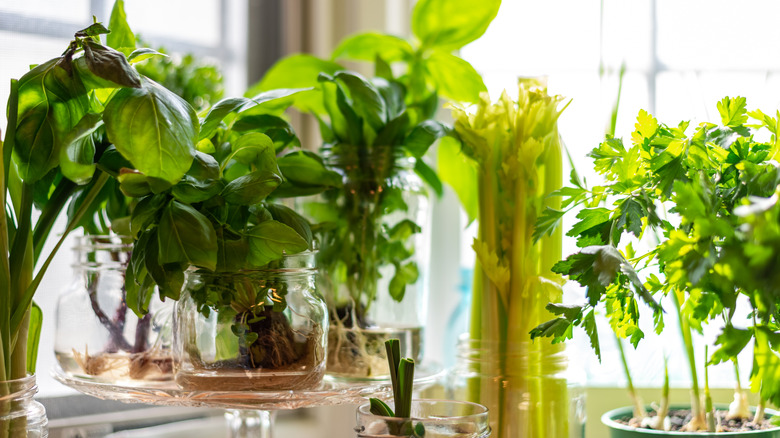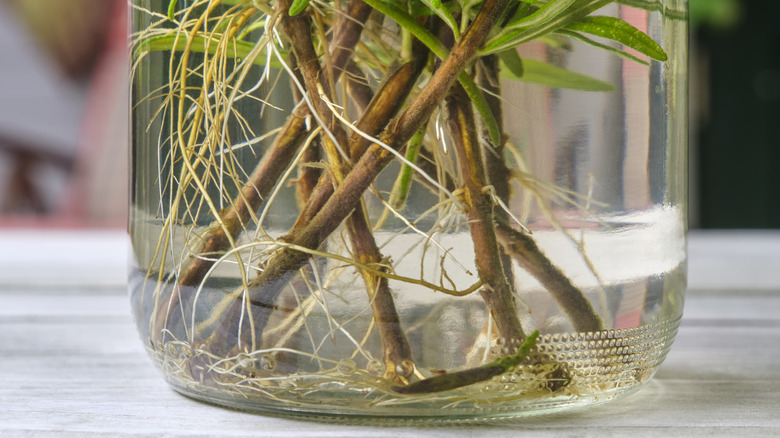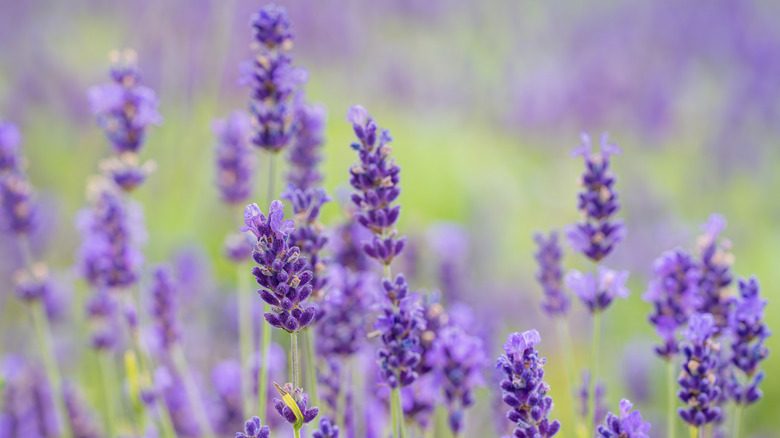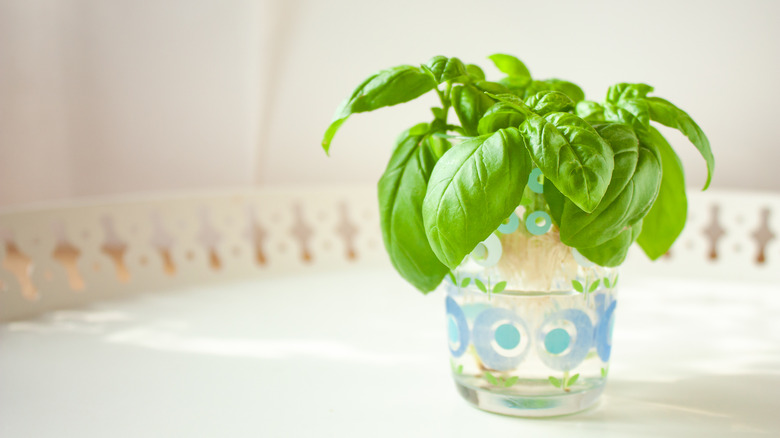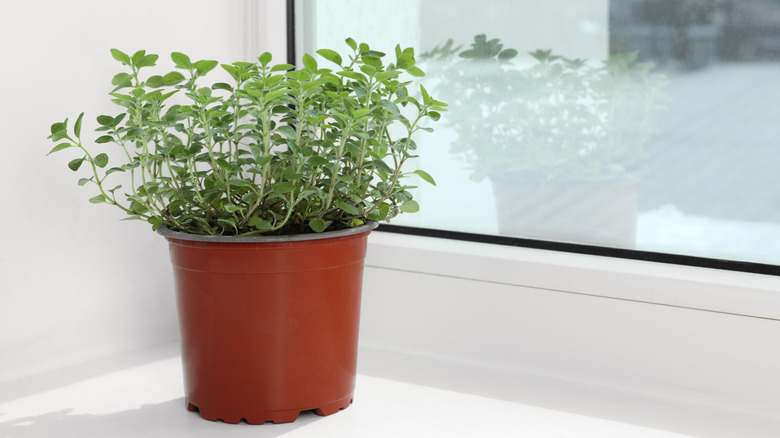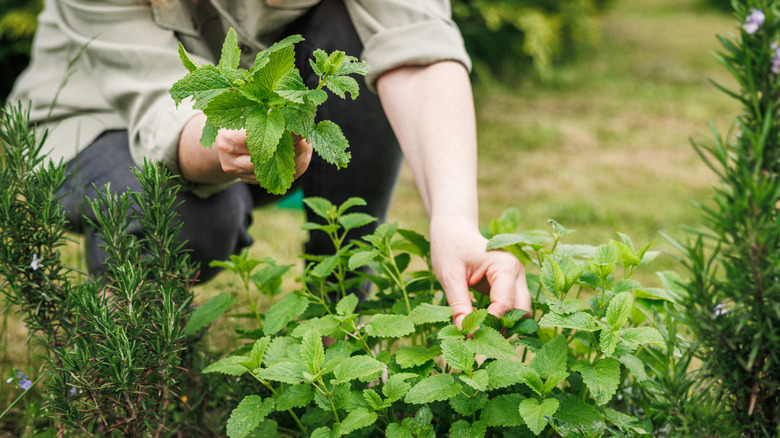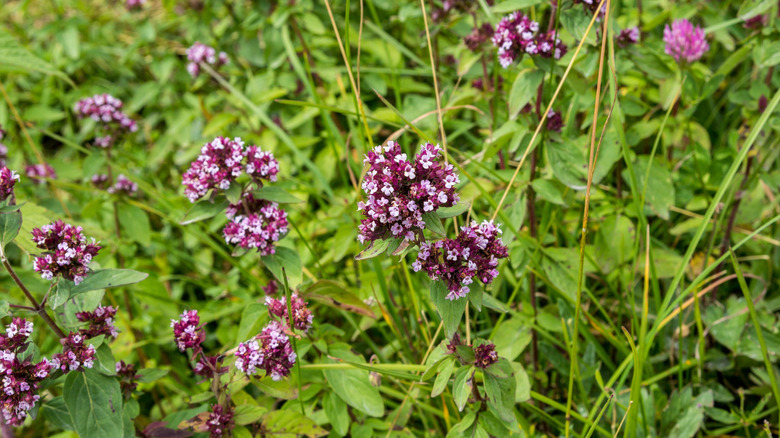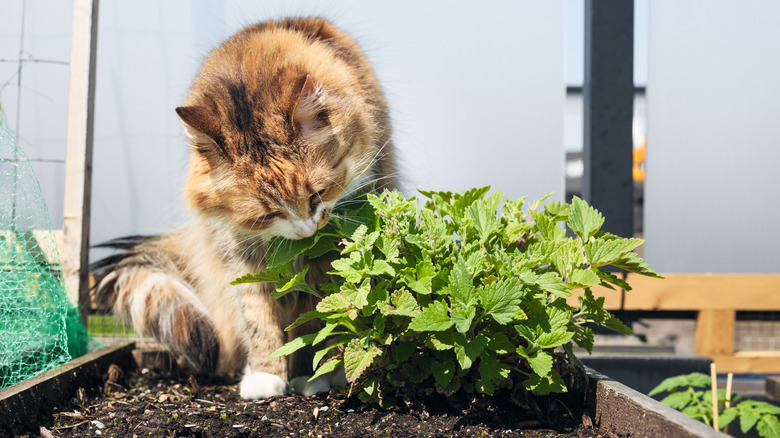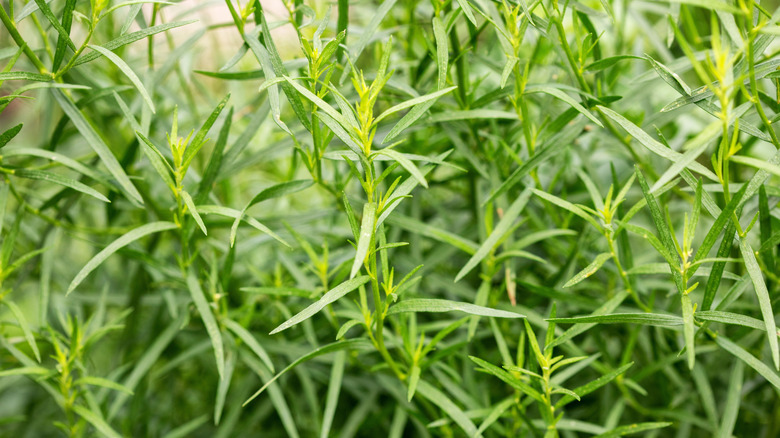12 Herbs You Can Easily Propagate From Cuttings In The Winter
Going all winter without an herb garden is miserable. Not only are they pretty, fragrant, and fun, they're also useful in the kitchen. Watching your herbs die down in winter and having to buy some from the grocery store for all your recipes is frustrating, and with herbs that don't survive the winter, like basil, this also means you'll have to buy new plants every spring. Well, you don't need to let them die. Winter is actually a great time to propagate herbs from cuttings, which allows you to grow new plants from the ones you already have. The best part is that propagating herbs is actually really easy, and you can do it from your house with very few supplies.
By propagating herbs during winter, when plants typically die down, you're securing a nearly continual supply of herbs. In many cases, you can take your cuttings right before winter, or at the very start of the season. Then, when placed in water or soil mix, these cuttings can establish new roots. Keep these cuttings warm indoors through winter, and by the time spring rolls around, you'll be able to transfer your new plants outside (or keep them in your indoor herb garden if you prefer).
The exact dates when you should cut, propagate, and transplant herbs depend on your region. Many herbs like basil, mint, oregano, and tarragon dislike frost, while others may tolerate going in the ground sooner. But don't worry — your house won't turn into a propagation lab. You'll just place herb stems into small cups of water or nursery pots and leave them on a windowsill to establish their roots. No need for growth lamps and trays; you can do it with what you have at home.
Rosemary
Rosemary (Salvia rosmarinus) is a great herb to propagate, and you can take cuttings from an outdoor plant before temperatures drop. In many cooler regions of the United States, outdoor rosemary plants die in winter once temperatures dip below 20 degrees Fahrenheit. But if you cut 6 inches from one of your plant's stems and pop it in some water, you can propagate a new plant during winter. Dip the stem in some cinnamon (which acts as an anti-fungal) beforehand, and in no time, the cutting will have roots. Transfer into a pot and you have a new plant.
Sage
Sage (Salvia officinalis) is a hardy perennial, meaning it can survive the winter in some parts of the country. It can also be propagated from hardwood cuttings gathered in the fall and winter while the plant is dormant. Dip the cuttings in rooting hormone and place them in a cup of water or sand on a windowsill where they will get lots of light. The plant will start growing in the spring after its dormant period is over. Then, once the last frosts have passed, the plant can be moved outside.
Lavender
Lavender (Lavandula spp.) cuttings can also continue to grow through winter if they're indoors. For these, take cuttings from the plant towards the end of fall, before temperatures drop in winter. When taking cuttings in the fall, you should make sure to use hardwood cuttings, which are the older and harder stems from the plant. The cuttings will do better if planted in well-draining soil, but they can also be propagated in water if you prefer. All that matters is that you keep them inside through winter.
Thyme
You can propagate thyme (Thymus vulgaris) from cuttings at any time of the year, including winter, as long as you're doing it indoors. Simply take stems from your thyme and remove the smaller leaves from the bottom 2 inches (use them for dinner!). Place the stems in a cup of water, and put it near a window. They prefer mild temperatures around 68 degrees Fahrenheit and lots of sunlight. Once they have roots, keep the new plants in nursery pots indoors until early spring, when they can be transferred into the garden.
Bay laurel
Bay laurel (Laurus nobilis) isn't the easiest herb to propagate, but if you're patient and attentive, it can work. And since bay trees are rather expensive, learning how to propagate them is a good way to increase your production without spending more money. Ideally, you'll want to cut clippings in the fall. Pluck stems from your parent plant and place them in a small pot filled with well-draining soil. Cover the cutting with a plastic bag, which you'll keep on throughout winter. If you're lucky, you'll have a brand new plant that you can repot next fall.
Basil
Basil (Ocimum basilicum) is known to be sensitive to cold temperatures below 40 degrees Fahrenheit, but it can actually be propagated from cuttings all year long, including in winter, as long as it's done indoors or in greenhouses. When winter is behind you and there are no risks of frost, you can transplant these cuttings to the garden. And when winter rolls around again next year, simply take a cutting from the plant before it dies, and propagate it again. Now, you've got a never-ending supply of fresh basil!
Mint
Mint (Mentha spp.) is a popular herb that you should grow from cuttings. Mint cuttings can thrive all year long, as long as they're not exposed to frost. If you live in colder regions of the United States, it might be best to keep the cuttings indoors for the coldest months of the year. Easily propagate mint cuttings by placing them in a cup of water (only the stem, not the leaves) for a week or two. Once you see roots, transfer the cuttings to a pot. Even if you're planting them outside, always use containers to avoid overspreading.
Oregano
Oregano (Origanum vulgare) cuttings can also develop roots in water, which makes them an easy choice for propagation. To do this, take some 5-inch stems from the parent plant and place them in a water cup. With indirect light and warmth, these cuttings will develop roots and can go into a small pot to continue to establish themselves through winter. Once the final frost of the year has passed, they can go outside, but exact timing will depend on where you live and the intensity of the winters.
Lemon balm
Lemon balm (Melissa officinalis) should be pruned and trimmed down at the very start of winter or slightly beforehand. This gives you the perfect opportunity to take some cuttings to propagate. Grab some stems and place their ends in a small cup of water, replacing the water often. Before transferring them to soil, wait for the cuttings to develop some roots. Transfer your new plants outdoors when there is no more risk of frost in your area. When growing and caring for lemon balm, try to use containers to prevent it from spreading out of control.
Broad-leaf thyme
While propagating true thyme from cuttings is possible, it can be a bit challenging. If you're a beginner looking for a slam-dunk, consider broad-leaf thyme (Thymus pulegioides) instead. This herb is not as woody as true thyme, which makes it easier to propagate. Here, follow the same process as with true thyme. Cut off 6-inch stems from the parent plant and remove the leaves from the bottom section. Place the cuttings in a glass of water before transferring to pots when they show healthy roots. Place them outdoors only when there is no risk of extreme cold snaps.
Catnip
Catnip (Nepeta cataria) is a fast-growing herb that only needs a bit of water to propagate — and one that your cat will love rolling around in. As always, remove the leaves from the submerged section of the stems, and change the water often until there are roots. Once transferred into a nursery pot, the new plant needs a bit of time to establish itself, which makes it perfect for winter propagation. By the time the plant has grown strong, you'll be able to transfer it to the garden for spring.
French tarragon
French tarragon (Artemisia dracunculus 'Sativa') is a fun herb that you can easily propagate from cuttings. Cut younger stems from the parent plant and remove the leaves on the bottom section, and transplant them into a nursery pot filled with soil mix. Beforehand, it's best to dip the cuttings in rooting hormone to help them thrive. Over winter, the cuttings will establish their roots and be ready to be transplanted when spring rolls around, once there is no risk of frost in your region.
